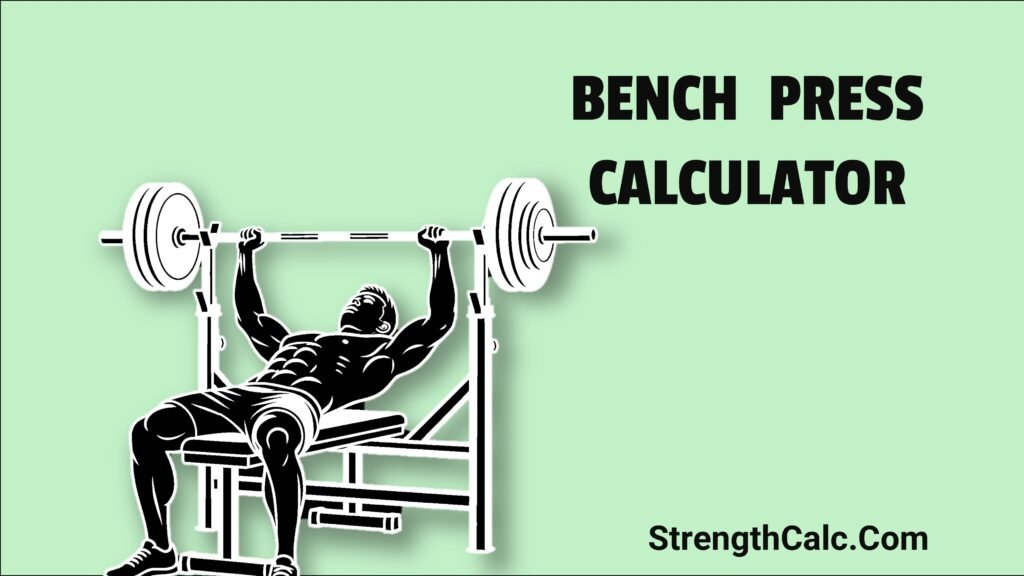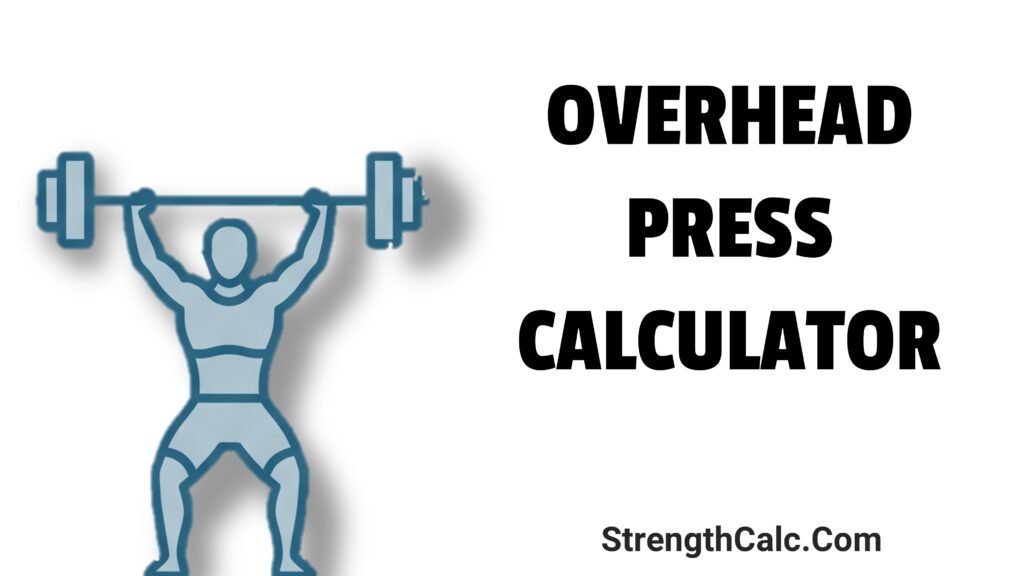Want to know how much you can bench — really?
This free Bench Press 1RM Calculator gives you an accurate estimate of your one-rep max based on reps and weight — no spotter or gym ego required. <div class=”powered-by” style=”text-align:center; margin-top: 10px;”> Powered by <a href=”https://strengthcalc.com” target=”_blank” rel=”noopener”>StrengthCalc.com</a> </div>
Bench Press 1 Rep Max Calculator
Your Estimated Bench Press 1RM is
Formula Comparison
Training Percentages
| % of 1RM | Weight |
|---|
Are these results accurate? These formulas provide a very good *estimate* of your 1RM. They are most accurate for reps between 2 and 10. The different formulas use slightly different mathematical models, which is why the results vary, especially at higher rep ranges. The primary result shown above is based on the widely-used Epley formula.
Why Use a Bench Press 1RM Calculator?
The bench press is the world’s most popular strength lift.
It’s a universal benchmark for upper body power — whether you’re a powerlifter, bodybuilder, athlete, or casual gymgoer.
But testing your 1RM in the gym can be:
- Risky (especially without a spotter)
- Fatiguing (max efforts drain recovery)
- Logistically tricky (how many warm-ups? when to test?)
That’s where our bench press 1RM calculator comes in.
Just enter:
- Weight lifted
- Reps completed (2–10 works best)
- Choose kg or lbs
→ and get instant 1RM estimates from multiple formulas.
How Does It Work?
This calculator uses four tried-and-tested equations to estimate your 1 rep max:
| Formula | Best For |
|---|---|
| Epley | Standard gym use, 3–10 reps |
| Brzycki | Popular among coaches and textbooks |
| Mayhew | Used in football/athletic testing |
| Lombardi | Best for higher reps (6–12) |
Default output is Epley, because it’s reliable, fast, and widely supported.
Epley Formula:
1RM = weight × (1 + reps ÷ 30)
Example:
100 kg × (1 + 5 ÷ 30) = 116.6 kg estimated 1RM
Training Percentages Based on Your 1RM
Once your estimated 1RM is calculated, we break it down by training intensity:
| % of 1RM | Usage |
|---|---|
| 100% | Max testing (rare!) |
| 90–95% | Heavy singles/doubles |
| 80–85% | Strength sets (3–5 reps) |
| 70–75% | Hypertrophy / volume (6–10 reps) |
| 60–65% | Warm-up / deload |
| 50% | Rehab / technique focus |
These %s are what most strength programs — like 5/3/1, RTS, Candito, or Texas Method — are built around.
Why the Bench Press Still Reigns Supreme
It’s not just about chest size. The bench press:
✅ Develops pushing strength
✅ Builds the chest, shoulders, and triceps
✅ Reinforces upper body symmetry
✅ Helps improve other lifts (like the overhead press)
✅ Is a measurable strength standard worldwide
And yes… it’s the first question every guy gets at the gym:
“How much ya bench?”
Technique Tips for a Bigger, Safer Bench
Whether you’re training for powerlifting or general strength, great technique matters. Here’s how to press like a pro:
Setup:
- Eyes under the bar
- Feet firmly planted
- Slight arch in your lower back
- Shoulder blades pulled together
- Hands just outside shoulder width
During the Lift:
- Inhale and brace before unracking
- Lower with control to mid-sternum
- Elbows at ~45° angle
- Press explosively back and slightly up
- Exhale at the top
Avoid:
- Flaring elbows wide
- Bouncing off the chest
- Pressing toward your face
Form ≠ ego. You’ll lift more, longer, and pain-free.
When to Estimate vs Test a True 1RM
✅ Use the calculator when:
- You’re mid-program and want to check progress
- You’re fatigued or deloading
- You don’t have a spotter
- You’re doing submax volume sets
❌ Test a real 1RM only when:
- You’re fully rested
- You’ve prepped with a peaking cycle
- You have safety equipment or spotters
- You need a PR for competition or program reset
💡 Pro tip: Estimate monthly. Test quarterly.
Bench Press Strength Standards (By Bodyweight)
| Level | Men (× BW) | Women (× BW) |
|---|---|---|
| Beginner | 0.5× | 0.35× |
| Intermediate | 1.0× | 0.65× |
| Advanced | 1.5× | 0.85× |
| Elite | 1.75–2.0× | 1.0–1.25× |
A 100 kg man benching 150 kg = Advanced
A 65 kg woman benching 65 kg = Intermediate to Advanced
Compare your estimated 1RM and see where you rank.
Legendary Bench Press Records
Let’s get inspired by some absurd numbers.
🏆 Raw Bench Records (2025):
- Julius Maddox (USA): 355 kg (782 lbs) — World Raw Record
- Danial Zamani (Iran): Unofficial 360 kg in training
- Jen Thompson (USA): 148.5 kg (327 lbs) @ 67.5 kg BW (raw)
- April Mathis (USA): 204 kg (450 lbs) @ SHW — jaw-dropping
These athletes are exceptions. But their discipline, not just DNA, created these records.
Bench Press Variations to Improve Your 1RM
🔁 Rotate variations to improve sticking points:
- Paused Bench Press: Builds control and confidence
- Close Grip Bench: Builds triceps strength
- Slingshot Bench: Overload top range
- Incline/Decline Bench: Targets different angles
- Board Presses / Pin Presses: Build lockout power
Combine them with accessory work:
Dumbbell presses, skull crushers, dips, rows, and face pulls.
Programming with Your Estimated 1RM
Use your 1RM to build a full 4–6 week strength block.
Example (based on 1RM = 120 kg):
- Week 1: 5×5 @ 75% (90 kg)
- Week 2: 5×4 @ 80% (96 kg)
- Week 3: 5×3 @ 85% (102 kg)
- Week 4: Deload or AMRAP @ 70% (84 kg)
- Repeat with +2.5–5 kg if successful
Your training should be guided by numbers, not guesses.
FAQ – Bench Press 1RM Estimator
Q: How accurate is the calculator?
Very accurate for sets of 2–10 reps with good form. Don’t use 12–15+ reps — endurance skews results.
Q: Can I use touch-and-go sets?
Yes, but paused reps give more precise strength data.
Q: What about incline or dumbbell bench?
The calculator is calibrated for flat barbell bench press. Use results from other lifts only as loose indicators.
Q: Can I use this during a cut or bulk?
Absolutely. It’s a great way to track strength trends during any phase.
Q: How often should I recalculate?
Every 3–6 weeks or after a new rep PR.
Wrap-Up: Let Your Press Speak
The bench press is more than a number — it’s a symbol of upper body strength and consistency.
Whether you’re chasing 60 kg or 200 kg, knowing your 1RM helps you train smarter, recover better, and set meaningful goals.
📌 Bookmark this calculator.
📈 Test your strength.
🧠 Train with intent.



